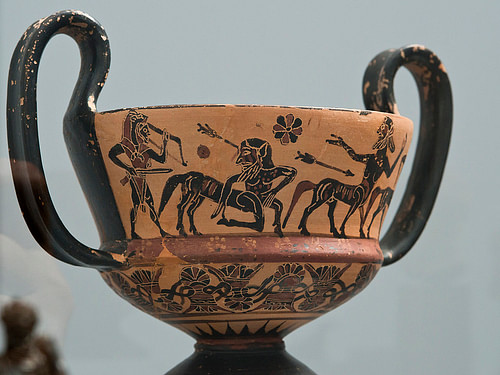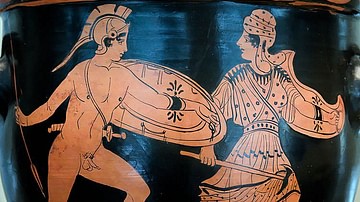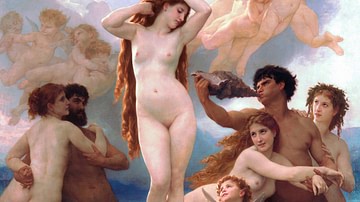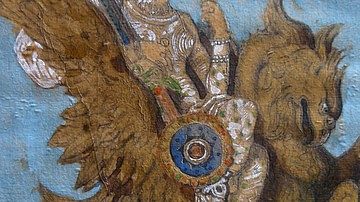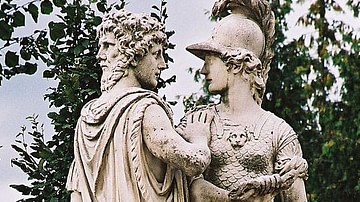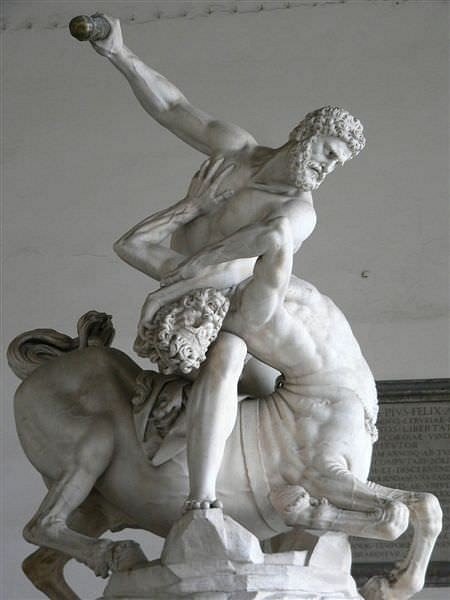
A centaur was a creature from Greek mythology which was half-man and half-horse. The head, arms and torso of a centaur were human and joined at the waist to the body and legs of a horse. Centaurs represented barbarism and unbridled chaos and were frequently represented in Greek architectural sculpture and pottery decoration.
Despite the bestial and lustful reputation of centaurs, some of them were not unfavourably portrayed in Greek myths, at least when they were not under the effects of wine. Perhaps, then, these horse creatures are a cautionary metaphor for the dangers we all face if we should forget our civility and lose control of our faculties and reason.
The Origin of Centaurs
The father of the centaur race was Centaurus, himself the offspring of Ixion who had made love to Hera, or more precisely, a cloud made by a jealous Zeus to resemble Hera. The centaurs were believed to live in the forests of Thessaly, beyond the laws of man. These mythical creatures may actually have had a basis in reality as there was a tradition in Thessaly of hunting bulls on horseback and the very word centaur may have originally meant 'bull-killer'. Perhaps the horsemen of Thessaly were so skilled that they seemed at one with their horse and so the myth of a single creature was born.
The Centaur Chiron
Perhaps the most famous centaur was Chiron (or Cheiron). A more civilised centaur, Chiron was known for his great wisdom and as the tutor of the god of medicine Asklepios and the heroes Hercules, Achilles and Jason (and his son Medeus). He is a shadowy figure in mythology and as only a minor character in many myths, details are scarce. We know from Hesiod that he was the son of Philyra (daughter of the Titan Oceanus) and that he was married to the nymph Chariklo; a rare depiction of her in art can be seen on a Corinthian plate (c. 600 BCE) where she is named. Chiron is also believed to have lived in the forests of Mt. Pelion. He is most commonly represented wearing a short tunic (chitoniskos) and a cloak and often carrying a branch over his shoulder from which hang hunted animals such as foxes and hares. Perhaps indicating his reputation as being the most civilized centaur, his front legs are often human and he is generally less hairy in both legs and torso in respect to the other centaurs. In mythology, Chiron was an advisor to Peleus and he is often associated with the king's wedding to Thetis (the Nereid), appearing on representations of the event in Greek art. The couple's son Achilles was entrusted to wise Chiron for his education during his adolescent years. The great hero also inherited a formidable spear made from Pelian ash which Chiron had given to Peleus. This spear was so large and heavy that only Achilles was sufficiently strong and skilled enough to wield it, something he does with great effect in Homer's description of the Trojan War in the Iliad where the spear is twice specifically mentioned as a gift from Chiron.
The Centaur Pholos
A second famous centaur in mythology is Pholos, who hosted the Greek hero Hercules while he was engaged in hunting for the giant boar, one of his celebrated labours in service to Eurystheus. Philos offered Hercules food and his cave as a place to rest from the hero's labours and together they had a quiet drink from the gigantic wine-filled pithos jar that belonged to all of the centaurs and had been a special gift from Dionysos, the god of wine. However, attracted by the smell of the wine, Pholos' fellow centaurs gate-crashed the party and, a little worse for wear after a few drinks, they began to get rowdy, in the end attacking Hercules. The centaurs were no match for the great hero though and the fight was predictably one-sided. Unfortunately, in the mayhem, Hercules accidentally killed Chiron with one of his poisoned arrows (dipped in the blood of the Hydra). Pholos was also killed in the incident after rather clumsily dropping a poisoned arrow on his foot. Perhaps, here again is another cautionary tale of the perils of poor hospitality and excessive drinking.
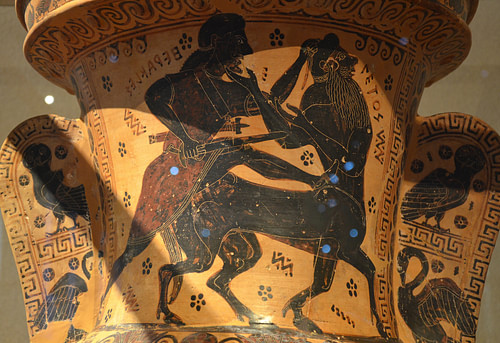
The Centaur Nessos
A third centaur we know by name is Nessos (or Nessus), who also foolishly picked a fight with Hercules. The hero and his new wife Deianeira, attempted to cross the river Evenus (or Euenos) on their way to Tiryns. Nessos offered to carry the girl across the water but halfway across molested his charge. Hercules, in a typically decisive response, swiftly fired one of his poisoned arrows at the centaur (although most pottery scenes of the myth depict Hercules with a club or sword). In his dying breath, Nessos tricked Deianeira by telling her to collect some of his blood, now poisoned because of the arrow, keep it in a jar away from the sun and use it as a love potion if Hercules' love should ever wane. Much later, with rumours of an affair between her husband and Iole, Deianeira, in order to win back Hercules' affections, smeared a cloak with the blood of Nessos. However, when the hero put on the cloak he was driven mad with the agony of the poison on his skin. In despair, Deianeira killed herself and without any hope of a cure Hercules threw himself on a funeral pyre on Mt. Oite. In a happy ending to the tragedy, Hercules was given an immortal place on Mt. Olympus where he married Hebe, the goddess of youth.
How Are Centaurs Represented in Art?
A Centauromachy, that is a battle between centaurs and gods or heroes, was a popular subject for decorative sculpture on ancient Greek buildings, particularly temples. The most celebrated example is without doubt from the west pediment of the Temple of Zeus at Olympia (c. 460 BCE). Here the centaurs, again after a bout of drinking, fight the Lapiths (from northern Thessaly) at the wedding of their chief Peirithoos to Deidameia and they attempt to abduct the bride. The protagonists are all involved in a lively struggle and strike dramatic entangled postures. Apollo majestically dominates the centre of the piece, standing tall and with arm outstretched, he brings calm to the chaos brought about by the uncivilized centaurs. The centaurs here represent the struggle between barbarism and civilization and may specifically be a metaphor for Greece's victory over Persia in the early 5th century BCE.
Centaurs are also represented on several metopes of the Parthenon, on the bronze shield of the bronze Athena by Pheidias and on the sandals of the cult statue of Athena inside the Parthenon. In addition, both the temple at Foce del Sele (Sicily) and the Temple of Athena at Assos are decorated with a centauromachy in sculpture.
Centaurs are a popular subject in Greek pottery decoration. Hercules fighting Nessos first appears on a 7th century black-figure amphora and appears on close to a hundred surviving vases. Chiron at the wedding of Thetis and Peleus, and Achilles being handed into the care of Chiron are frequent representations on Attic black-figure and red-figure pottery from the 6th to 5th centuries BCE. Similarly popular are scenes depicting Hercules' battle with the centaurs after dining with Pholos, the first appearing on Corinthian vases of the 6th century BCE. Centaurs also appear in company with Dionysos and in depictions of his associated festivals. Finally, there are also rare representations of Medusa as a centaur, for example on an amphora from Boeotia, c. 660 BCE.
